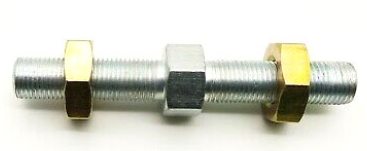In the world of engineering and construction, the choice of thread type is paramount for ensuring secure and reliable fastenings. Understanding the nuances of thread profiles is crucial for achieving optimal performance and longevity in various applications.
This article delves into the specifics of UNF thread, highlighting its characteristics, advantages, and best practices for its use.
What is UNF Thread?
UNF stands for Unified National Fine thread. It’s a standardized thread profile characterized by a fine pitch, meaning it has more threads per inch compared to its coarser counterpart, UNC (Unified National Coarse). This finer pitch provides several key advantages in specific applications.
Key Features of UNF Thread
Fine Threading:
The defining characteristic of UNF is its high thread count per inch. This results in:
➡️ Increased Precision: Offers greater control and finer adjustments in applications requiring precise positioning.
➡️ Enhanced Strength: Distributes stress more evenly, leading to improved load-bearing capacity.
Dimensions and Specifications:
UNF threads adhere to strict dimensional standards, ensuring compatibility and interchangeability across various components. These standards are crucial for maintaining consistency and reliability in manufacturing and assembly.
Materials:
UNF threads can be manufactured from a wide range of materials, including:
➡️ Steel: A common choice for its high strength and durability.
➡️ Stainless Steel: Offers excellent corrosion resistance for use in harsh environments.
➡️ Aluminum: Lightweight and appropriate for uses where it’s important to reduce weight.
➡️ Brass: Provides good electrical conductivity and is often used in electrical applications.
Advantages of Using UNF Thread
➡️ Enhanced Grip and Security: The fine pitch provides a tighter grip, making it ideal for applications where vibration or high loads are present. This minimizes the risk of loosening or failure.
➡️ Ideal for Thin Materials: UNF threads are well-suited for thin materials as they minimize the risk of thread stripping or pulling out of the material.
➡️ Compatibility: UNF threads are widely used across various industries and applications, ensuring compatibility with a broad range of components.
Common Applications of UNF Thread
➡️ Aerospace and Automotive Industries: Critical applications in aircraft and vehicles often require the precision and strength that UNF threads provide.
➡️ Medical Devices and Precision Equipment: The fine pitch and precise control offered by UNF threads are essential in the manufacturing of medical devices and precision instruments.
➡️ Everyday Tools and Hardware: Many everyday tools and hardware components, such as camera mounts, fine-threaded screws, and precision instruments, utilize UNF threads.
How to Identify UNF Thread
1. Tools and Techniques:
➡️ Thread Pitch Gauge: A specialized tool with various slots that can be used to measure the number of threads per inch.
➡️ Micrometer: Can be used to measure the thread diameter and pitch.
➡️ Visual Inspection: Experienced technicians can often identify UNF threads by their appearance, comparing them to known UNC threads.
2. Understanding Thread Pitch and Diameter: The number of threads per inch is a key identifier. UNF threads typically have a higher thread count than UNC threads for a given diameter.
3. Differentiating from Other Thread Types: Familiarity with other thread standards, such as metric threads, is crucial for accurate identification.
Choosing the Right UNF Thread Fastener
1. Factors to Consider:
➡️ Application: The specific demands of the application, such as load, vibration, and environmental conditions, will dictate the appropriate thread size and material.
➡️ Material Compatibility: Ensure compatibility between the thread fastener and the materials it will be used with.
➡️ Load Capacity: Select a fastener with sufficient load-bearing capacity to withstand the anticipated loads.
2. Compatibility with Nuts, Bolts, and Other Components: Ensure proper mating of the thread with other components in the assembly.
3. Tips for Ensuring Proper Installation and Maintenance:
➡️ Use appropriate tools to avoid damaging the threads.
➡️ Apply proper torque to ensure a secure and reliable connection.
➡️ Regularly inspect fasteners for signs of wear and tear.
➡️ Implement proper maintenance procedures to prevent corrosion and ensure long-term reliability.
Challenges and Solutions When Using UNF Thread
1. Addressing Wear and Tear: Fine threads are more susceptible to wear and tear than coarser threads. Regular inspection and replacement can help mitigate this issue.
2. Preventing Cross-Threading and Thread Stripping: Proper alignment and careful installation techniques are crucial to prevent cross-threading and thread stripping.
3. Maintenance Tips for Long-Term Reliability:
➡️ Keep fasteners clean and free from debris.
➡️ Apply appropriate lubricants to reduce friction and wear.
➡️ Regularly inspect and replace worn or damaged fasteners.
Conclusion
UNF threads play a vital role in ensuring the secure and reliable performance of countless applications. By understanding their characteristics, advantages, and proper usage, engineers and technicians can make informed decisions to optimize project outcomes. Choosing the right UNF thread fastener for a given application can significantly improve its durability, precision, and overall performance.
Remember: Always refer to relevant industry standards and consult with qualified professionals for specific applications.
Post time: Jan-09-2025


